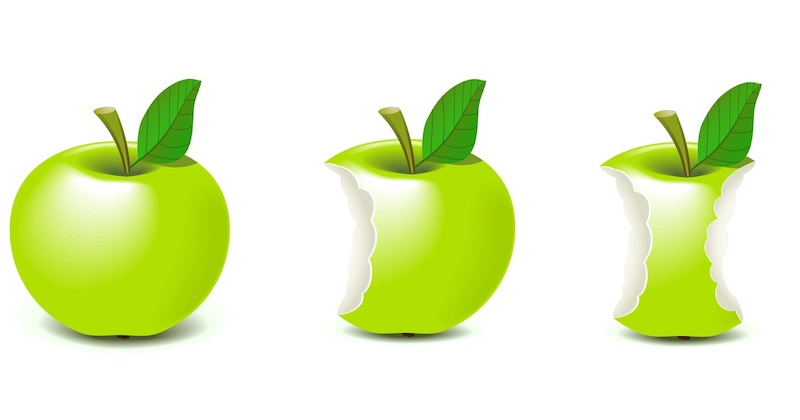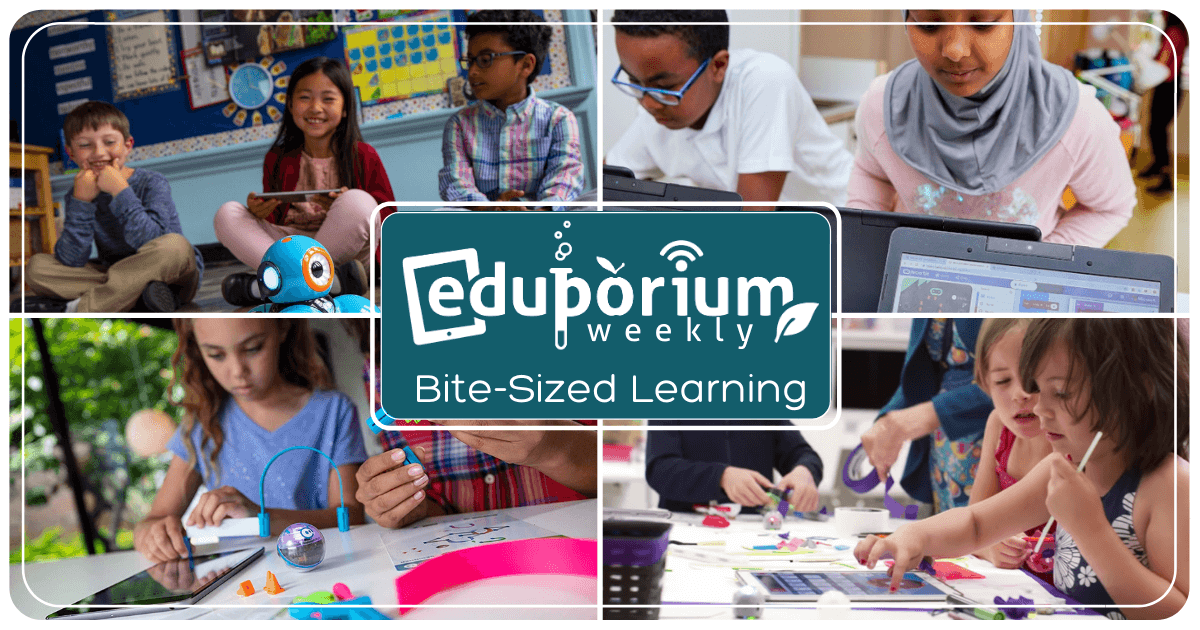With so many different types of teaching and learning appearing, chances are educators have tried one or two out. There's flipped learning, self-paced learning, and, these days, remote, hybrid, and synchronous learning. So, what's one more thrown into the mix? This week, we're talking about bite-sized learning. Bite-sized learning involves teaching with short and highly focused lessons. They typically cover one specific topic and feature clear learning objectives for students to meet. And, when utilized consistently, these types of experiences can be very beneficial for many of them.
What is Bite-Sized Learning?
Bite-sized learning is a type of personalized learning. It's designed to enable students to better focus on and master specific content areas or concepts. It can also help educators meet unique and specific needs of students more effectively. Bite-sized learning is often used to better reach students with different preferred learning styles. This often prevents students from having to adapt to the lesson delivery and, instead, only adapt to the subject matter. Ultimately, receiving instruction in this way can motivate students to seek out learning opportunities on their own.
Who benefits from this approach?
Bite-sized learning helps students by allowing them to focus their attention on specific areas for shorter periods of time. Lessons are very short and the subject matter is often very specific. Teachers can still break bite-sized instruction up into units, but these units typically contain only the essential information students need to know as well as clearly defined learning objectives. Since many students have different learning styles, preferences, and abilities, bite-sized learning can help educators focus on what's most important. From there, they can highlight these elements and provide students with the most relevant content and experiences.
How to use bite-sized learning.
In bite-sized models, the curriculum is often problem-based and student-centered. This allows students to learn the exact information they need at the exact time they need to know it. Rather than using long lectures that include information that's not vital, bite-sized learning allows teachers and students to focus on the important parts. The medium in which students consume the content can vary as well. It can include short vides, articles, or completing a quick assignment. In the remote learning era as well, bite-sized learning can be an effective approach to engaging students and ensuring they're learning what they need to know.
Key Principles of Bite-Sized Learning
While often an effective strategy, attempts at bite-sized learning still need to be structured and purposeful. More and more students respond to this kind of instruction these days—even in remote learning. Today's students want the information they need quickly. They want educational content delivered in the same ways they consume other media. For them, this means bite-sized chunks that are accessible any time and from anywhere. With engagement remaining the ultimate goal, it's crucial that educators know how to reach today's students while also keeping in mind that things might only wind up getting more concentrated over the next few years.
Strategies for educators to remember.
The first strategy to remember is to really make sure you stick to one main idea. In bite-sized learning, meeting periods are short and this time should be spent on one major topic. Students also benefit from immediate engagement on that topic. Don't waste time with small talk or irrelevant information. That brings up another suggestion—one that's common when it comes to bite-sized instruction. Educators should all but eliminate fluff and filler. If it's not relevant, it's not necessary. Getting right to the chase and being direct are two ways to achieve this. Using varying types of media to supplement the conversation can also be helpful.
Bite-sized learning context and chunking.
Some educators also suggest strategically chunking content when presenting it to students. Talking about similar topics at the same time helps them remember things more easily. Also, providing real-world context can help students better understand the information. Students benefit from a clear perception of what they'll be able to do with the new information they're learning—not just being told that they need to know it. This helps them start to believe that they can solve real problems. Finally, it's not a bad idea to mix in mini assessments to check what students have absorbed and how they'd apply that knowledge going forward.

Why Bite-Sized Learning Matters
There are a bunch of benefits to bite-sized learning and reasons it's important. These days, however, it's natural to wonder how an educational trend or approach translates to remote and hybrid learning as well as in-person instruction. At its core, bite-sized learning can benefit remote students. It could allow both students and teachers to focus in on what's most important. Plus, in an era in which teachers are crunched for time and facilitating shorter class meetings, breaking things down into bite-sized portions can help. Bite-sized learning, of course, allows students to identify and process information more quickly. It's also a more flexible method, allowing educators to take advantage of quick lessons and meetings by providing content quickly.
Accessibility helps advance efficiency.
Bite-sized learning can allow educators to create and distribute learning resources when students need them. The shorter lessons and units certainly benefit today's students. It also doesn't hurt when teachers can make the content relevant to each of them. This includes utilizing media that's accessible on any type of device and providing different options, such as video and text, for students with different preferences. Bite-sized learning has also been used in the workforce in recent years. Much of what's been learned is now being applied with K-12 students as well. This includes the opportunity to explore how short but information-rich lessons impact learning. Covering a lot of content quickly and then taking a break has also been shown to be effective.
A shift in instruction moving forward?
Even after remote learning eventually fades away, educators now know it's a viable option. This may lead to remote instruction as a strategy to fill gaps for any students who need that. It could also put an end to snow days and allow educators to at least connect with students for short meetings when weather closes schools. As student demand for more personalized and concise content grows, so too has the ability for educators to give it to them. This includes the time they spend in the classroom as well as learning from home. It could help students better concentrate, reinforce key topics, and keep them better engaged. So, what's the harm in giving it a try?
Incorporating Bite-Sized Learning in the Classroom
Now that we've talked a bunch about the characteristics of bite-sized learning, let's discuss how to implement it. Like always, there's no blueprint for educators to follow. We'll simply provide some suggestions and educators can attempt strategies that align with what works in their classrooms. Since bite-sized lessons are short and concise, this sometimes makes finding useful resources easier. The resources don't have to cover a whole lot or be too in-depth, which is also good news. Most of the time, teachers will be using digital resources in bite-sized lessons. So, knowing where to find them and the features to look for is a good starting point.
Where to find relevant resources.
Keeping an eye out for digital resources is a good strategy. Other educators are constantly sharing things that have worked for them on their social media channels. Doing some research on your own is fine, too. If you know of a resource that might be effective in short, concise lessons, then looking into it is a good idea. Many of these resources might be videos and that's okay. For today's students, the shorter the videos are, the better. Obviously, this ties in with the premise of bite-sized learning—so long as the topics are completely relevant. Using social media to post inquiries about such resources is also often effective.
Different types of bite-sized lessons.
Beyond video, podcasts and even print resources can be useful in bite-sized learning. Just make sure that audio clips or blurbs from relevant articles aren't too long and filled with too much irrelevant content. If the resources are accompanied by relevant wrap-up lessons or assessments, that's even better. If possible, teachers can also meet students where they are by incorporating some of the apps they like. Using a mobile phone or tablet might make them think they're not even learning. Finally, try to break up text and video with other media, like pictures. Sometimes, consuming information in a variety of ways can also help with engagement and retention.
How Bite-Sized Learning Improves Attention
We've covered bite-sized learning from a lot of angles so far. To wrap things up, we'll now focus on how breaking things down affects student attention spans. Today's students have so many distractions at their finger tips, especially in remote learning. It's tougher and tougher for teachers to keep them engaged because they're wired to want information delivered to them quickly, concisely, and perhaps even with a bit of entertainment. Today's students grow up with distractions all around them and almost come to expect to be focusing on multiple things at once. With bite-sized learning, educators can acknowledge this fact and harness it productively.
Managing student attention spans through delivery.
Longtime instructional methods may not be as effective with the current generation of students. The speed at which things move has obviously increased and kids crave that kind of immediate satisfaction—something instructional technology can help with. Breaking down educational content into more manageable chunks allows educators to better meet student desires for on-demand learning. Many of them want to be able to consume information anywhere and at any time. Shortening lessons and highlighting the most important points helps teachers capitalize on shrinking attention spans. Since students can instantly access information from so many different sources, it's ideal when teachers can provide them with reliable content quickly.
Why bite-sized learning is used.
In addition to capitalizing on evolving attention spans, bite-sized learning provides other positives. For example, teachers and students could wind up becoming much more efficient. Instead of spending a whole day or class period on a drawn-out lesson, it could be completed in minutes, allowing more time for other things, like projects or assessments. Educators can also use this time to work with students who need extra attention. Also, introducing students to bite-sized approaches early on can help them better understand learning in today's world. It's fast-paced, continuous, and often requires their full attention—even if for short periods of time. If you've tried bite-sized learning with your students, let us know how it went in the comments!
For the latest EdTech, STEM, and 21st century education news, follow us on Twitter and Instagram. Like us on Facebook, too, or sign up for our newsletter for our latest product announcements and offerings. If you have an idea for an Eduporium Weekly theme, send us a message on social media or comment below.



